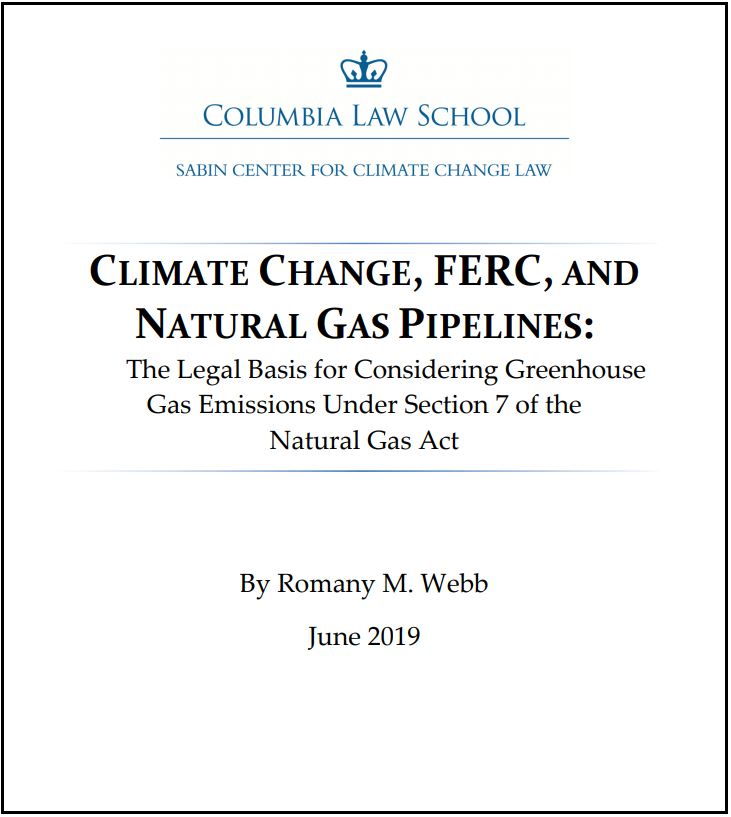By Romany Webb
 Last Tuesday, June 4, the D.C. Circuit decided the latest in a string of cases challenging the Federal Energy Regulatory Commission (FERC)’s approval of new interstate natural gas pipelines. The case – Birckhead v. FERC – focused largely on FERC’s obligation to consider the climate change impacts of pipeline development, which has recently become a key point of debate both within and outside the Commission. Much of the debate has centered on FERC’s obligations under the National Environmental Policy Act (NEPA). Comparatively little attention has been devoted to the obligations imposed on FERC by other statutes. That is the focus of a new Sabin Center working paper – “Climate Change, FERC, and Natural Gas Pipelines”– published today. The paper argues that the Natural Gas Act (NGA) establishes an independent requirement for FERC to consider climate change impacts when approving interstate natural gas pipelines. To support that argument, the paper provides a detailed analysis of section 7 of the NGA, which governs FERC’s pipeline approval process.
Last Tuesday, June 4, the D.C. Circuit decided the latest in a string of cases challenging the Federal Energy Regulatory Commission (FERC)’s approval of new interstate natural gas pipelines. The case – Birckhead v. FERC – focused largely on FERC’s obligation to consider the climate change impacts of pipeline development, which has recently become a key point of debate both within and outside the Commission. Much of the debate has centered on FERC’s obligations under the National Environmental Policy Act (NEPA). Comparatively little attention has been devoted to the obligations imposed on FERC by other statutes. That is the focus of a new Sabin Center working paper – “Climate Change, FERC, and Natural Gas Pipelines”– published today. The paper argues that the Natural Gas Act (NGA) establishes an independent requirement for FERC to consider climate change impacts when approving interstate natural gas pipelines. To support that argument, the paper provides a detailed analysis of section 7 of the NGA, which governs FERC’s pipeline approval process.
Under section 7 of the NGA, before approving an interstate natural gas pipeline, FERC must find that it “is or will be required by the present or future public convenience and necessity.” FERC’s finding must be based on an evaluation of “all factors bearing on the public interest,” which necessitates a broad-ranging assessment of the need for pipeline development and its likely impacts. While FERC purports to consider both economic and environmental impacts as part of its assessment, a review of recent pipeline approvals shows that it often focuses solely on economic issues. Even where environmental factors are considered, FERC typically fails to assess the full climate change impacts associated with pipeline development, including the greenhouse gas emissions resulting from “upstream” natural gas production and “downstream” use. This not only undermines the quality of FERC’s decision-making, but also arguably violates section 7 of the NGA.
In Birckhead v. FERC, as well as numerous other cases, the courts have recognized that the environmental impacts of pipeline development are relevant to FERC’s assessment of public convenience and necessity under section 7 of the NGA. In its early decisions under section 7, FERC routinely considered upstream and downstream environmental impacts, often with the approval of the courts. The court decisions, as well as the language and history of section 7, strongly suggest that FERC is legally required to consider upstream and downstream impacts under the NGA. FERC must, therefore, change its approach to evaluating pipeline projects. Going forward, FERC must consider projects’ full climate change impacts, including upstream and downstream greenhouse gas emissions. That could have significant implications for the approval of projects since, after accounting for upstream and downstream emissions, FERC may be unable to conclude that pipeline development is required by the public convenience and necessity.
Romany Webb is a Research Scholar at Columbia Law School, Adjunct Associate Professor of Climate at Columbia Climate School, and Deputy Director of the Sabin Center for Climate Change Law.





